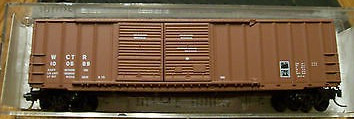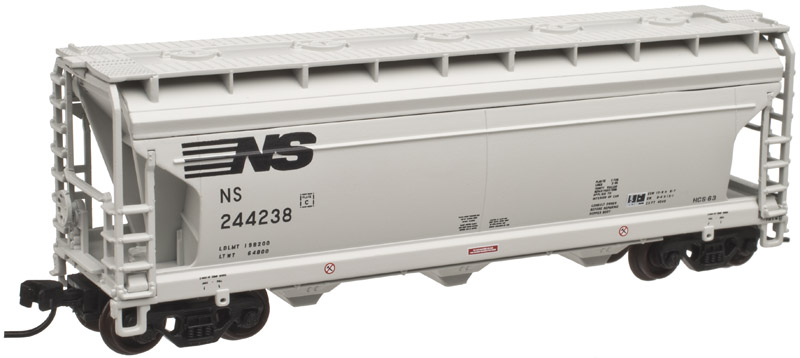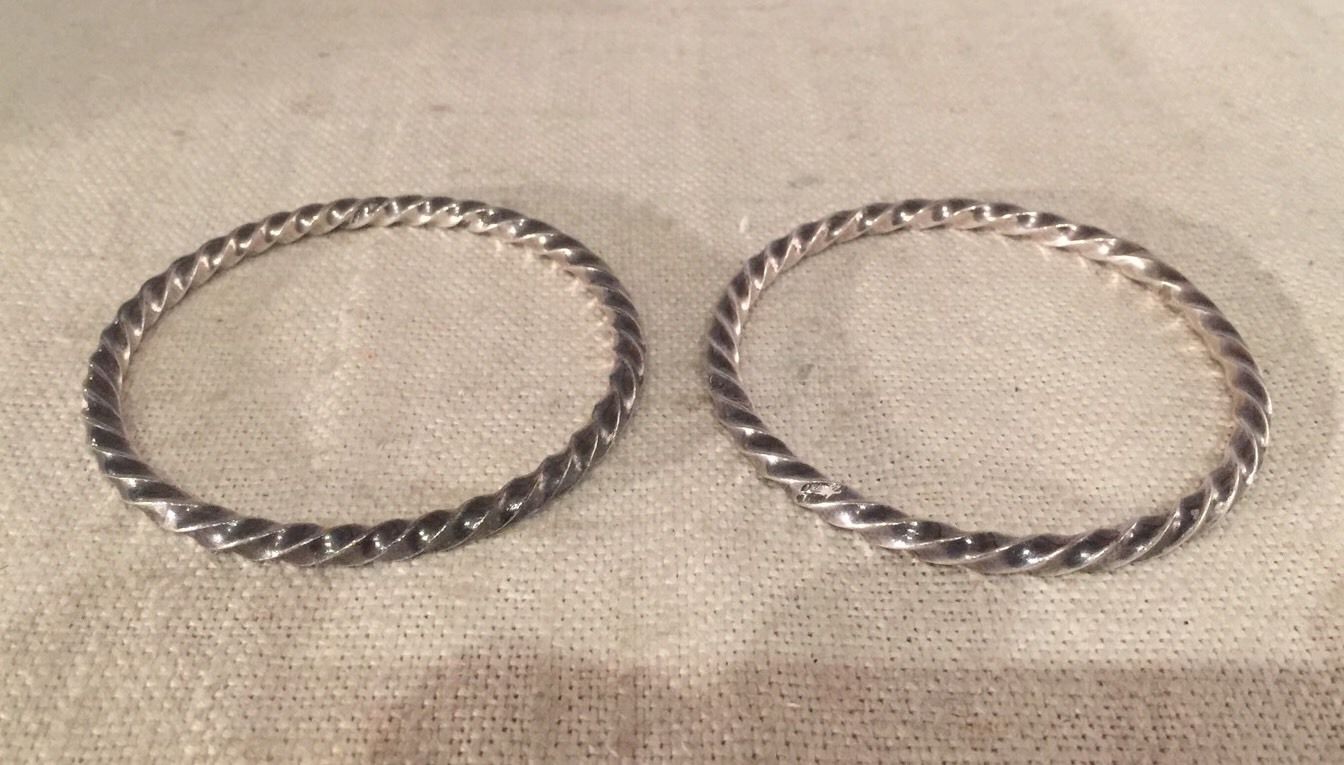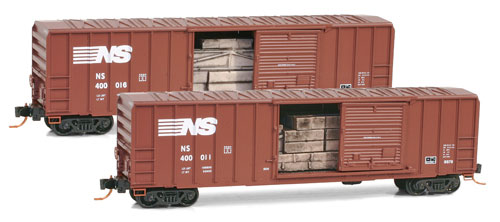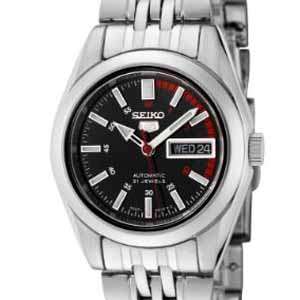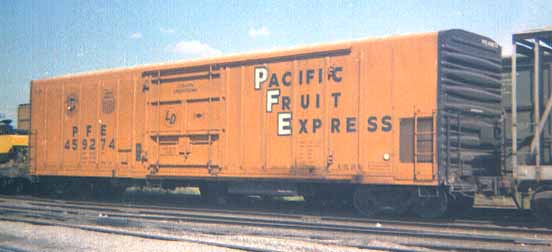Micro-Trains - 30120 - Boxcar, 50 Foot, Steel - White City Terminal - 100589
| Stock Number | 30120 |
| Secondary Stock Number | 030 00 120 |
| Original Retail Price | $10.20 |
| Brand | Micro-Trains |
| Manufacturer | Kadee Quality Products |
| Body Style | Micro-Trains 030 Boxcar 50 Foot Double Door Rib Side No Roofwalk |
| Prototype Vehicle | Boxcar, 50 Foot, Steel (Details) |
| Road or Company Name | White City Terminal (Details) |
| Reporting Marks | WCTR |
| Road or Reporting Number | 100589 |
| Paint Color(s) | Light Brown |
| Print Color(s) | White |
| Coupler Type | MT Magne-Matic Knuckle |
| Wheel Type | Plastic Wheels With Steel Axle |
| Release Date | 1985-11-01 |
| Item Category | Rolling Stock (Freight) |
| Model Type | Boxcar |
| Model Subtype | 50 Foot |
| Model Variety | Steel Rib, Double Sliding Door, No Roofwalk |
| Prototype Region | North America |
| Prototype Era | NA Era III: Transition (1939 - 1957) |
| Scale | 1/160 |
| Track Gauge | N standard |
Model Information:
Introduced in May of 1983, Micro-Trains has produced 57 different versions of this car through March of 2016, making it about 1% (or slightly above average) of their production. The car represents a fairly common prototype: 50 foot, double-door, exterior post box car. Like most sliding door models produced by Micro-Trains, the doors on this model do open.
Prototype History:
While the 40-foot boxcar was a standard design, and it did come in different setups depending on the type of freight being transported, it was not large enough for efficient mass commodity transportation. The 50-foot boxcar made its first appearance in the 1930s and steadily grew in popularity over the years, which further improved redundancies by allowing for even more space within a given car. Today, the 50-footer remains the common boxcar size. After the second world war ended, and steel became once again readily available, steel became the go-to choice for construction of boxcars. Pullman Standard and ACF were some of the most prolific builders of these cars.
These cars came in many variations. For instance, double-doors became practical for large/wide loads, end-doors useful for very large lading such as automobiles, and interior tie-down equipment was helpful in keeping sensitive products from being damaged in-transit. In 1954 the Santa Fe developed its "Shock Control" (and later "Super Shock Control") technology for new boxcars with upgraded suspension systems to further improve the ride-quality and reduce the chance of damaging freight.
In the 1960s, the flush, "plug" style sliding door was introduced as an option that provides a larger door to ease loading and unloading of certain commodities. The tight-fitting doors are better insulated and allow a car's interior to be maintained at a more even temperature.
These cars came in many variations. For instance, double-doors became practical for large/wide loads, end-doors useful for very large lading such as automobiles, and interior tie-down equipment was helpful in keeping sensitive products from being damaged in-transit. In 1954 the Santa Fe developed its "Shock Control" (and later "Super Shock Control") technology for new boxcars with upgraded suspension systems to further improve the ride-quality and reduce the chance of damaging freight.
In the 1960s, the flush, "plug" style sliding door was introduced as an option that provides a larger door to ease loading and unloading of certain commodities. The tight-fitting doors are better insulated and allow a car's interior to be maintained at a more even temperature.
Road Name History:
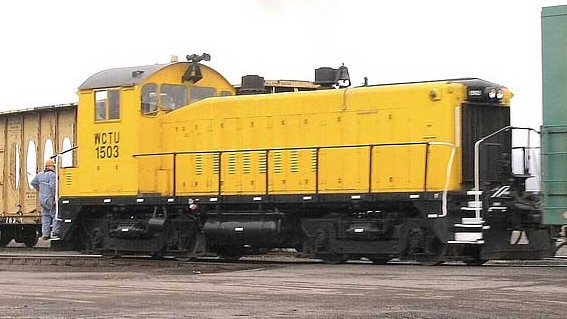 This 13 mile shortline was built in 1954 to run from White City, Oregon to a connection with Southern Pacific just north of Medford. For the first 20 years, they operated under the name White City Terminal & Utility. In 1974, the line was bought by Union Tank Car Line (UTLX) who changed the name to WCTU Railway (with WCTR reporting marks.) UTLX used the WCTR as a home road for leasing thousands of (non-tank) cars. WCTR parent UTLX had been acquired by Berkshire Hathaway who then purchased an energy company in Iowa that had its own common carrier shortline. When Berkshire Hathaway then purchased BNSF, it dawned on them that they now owned three common carriers without first obtaining federal approval. To prevent this development from collapsing their BNSF deal, BH quickly accepted an offer from CN engineer Scott DeVries to buy the WCTR. DeVries then reorganized the company as the Rogue Valley Terminal Railroad in 2013.
This 13 mile shortline was built in 1954 to run from White City, Oregon to a connection with Southern Pacific just north of Medford. For the first 20 years, they operated under the name White City Terminal & Utility. In 1974, the line was bought by Union Tank Car Line (UTLX) who changed the name to WCTU Railway (with WCTR reporting marks.) UTLX used the WCTR as a home road for leasing thousands of (non-tank) cars. WCTR parent UTLX had been acquired by Berkshire Hathaway who then purchased an energy company in Iowa that had its own common carrier shortline. When Berkshire Hathaway then purchased BNSF, it dawned on them that they now owned three common carriers without first obtaining federal approval. To prevent this development from collapsing their BNSF deal, BH quickly accepted an offer from CN engineer Scott DeVries to buy the WCTR. DeVries then reorganized the company as the Rogue Valley Terminal Railroad in 2013.

Brand/Importer Information:
Micro-Trains is the brand name used by both Kadee Quality Products and Micro-Trains Line. For a history of the relationship between the brand and the two companies, please consult our Micro-Trains Collector's Guide.
Manufacturer Information:
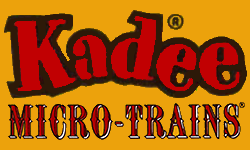 Kadee Quality Products originally got involved in N-Scale by producing a scaled-down version of their successful HO Magne-Matic knuckle coupler system. This coupler was superior to the ubiquitous 'Rapido' style coupler due to two primary factors: superior realistic appearance and the ability to automatically uncouple when stopped over a magnet embedded in a section of track. The success of these couplers in N-Scale quickly translated to the production of trucks, wheels and in 1972 a release of ready-to-run box cars.
Kadee Quality Products originally got involved in N-Scale by producing a scaled-down version of their successful HO Magne-Matic knuckle coupler system. This coupler was superior to the ubiquitous 'Rapido' style coupler due to two primary factors: superior realistic appearance and the ability to automatically uncouple when stopped over a magnet embedded in a section of track. The success of these couplers in N-Scale quickly translated to the production of trucks, wheels and in 1972 a release of ready-to-run box cars.
In October 1990 Kadee separated in two companies, with the newly created Micro-Trains® Line Co. continuing the Z, Nn3, and N Scale product ranges, with Kadee retaining the HO range.

In October 1990 Kadee separated in two companies, with the newly created Micro-Trains® Line Co. continuing the Z, Nn3, and N Scale product ranges, with Kadee retaining the HO range.
Item created by: nscalemodeler160
on 2016-04-08 03:37:10
Last edited by: gdm on 2020-10-23 16:58:37
If you see errors or missing data in this entry, please feel free to log in and edit it. Anyone with a Gmail account can log in instantly.
Last edited by: gdm on 2020-10-23 16:58:37
If you see errors or missing data in this entry, please feel free to log in and edit it. Anyone with a Gmail account can log in instantly.


